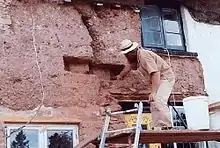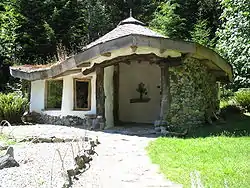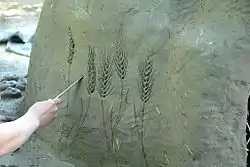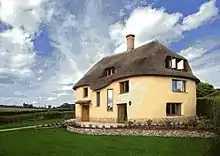Cob (material)
Cob, cobb or clom (in Wales) is a natural building material made from subsoil, water, fibrous organic material (typically straw), and sometimes lime.[1] The contents of subsoil naturally vary, and if it does not contain the right mixture it can be modified with sand or clay. Cob is fireproof, resistant to seismic activity,[2] and uses low-cost materials, although it is very labour intensive. It can be used to create artistic and sculptural forms, and its use has been revived in recent years by the natural building and sustainability movements.

In technical building and engineering documents, such as the Uniform Building Code of the western USA, cob may be referred to as an "unburned clay masonry" when used in a structural context. It may also be referred to as an "aggregate" in non-structural contexts, such as a "clay and sand aggregate" or more simply an "organic aggregate," such as where the cob is a filler between post and beam construction.
History and usage

Cob is an English term attested to around the year 1600[3] for an ancient building material that has been used for building since prehistoric times. The etymology of cob and cobbing is unclear, but in several senses means to beat or strike,[4] which is how cob material is applied to a wall.
Some of the oldest man-made structures in Afghanistan are composed of rammed earth and cob.[5] Cobwork (tabya) was used in the Maghreb and al-Andalus in the 11th and 12th centuries, and was described in detail by Ibn Khaldun in the 14th century.[6]
Cob material is known by many names including adobe,[7] lump clay,[7] puddled clay, chalk mud,[7] wychert,[7] clay daubins,[7] swish (Asante Twi),[8] torchis (French),[9] bauge (French),[9] bousille (French mud with moss),[9] and cat and clay.[10]
Cob structures can be found in a variety of climates across the globe. European examples include:
- in England, notably in the counties of Devon and Cornwall in the West Country, and in East Anglia (where it is referred to as clay lump)[11]
- in the Vale of Glamorgan and Gower Peninsula in Wales
- in Donegal Bay in Ulster and in Munster, South-West Ireland
- in Finisterre in Brittany, where many homes have survived over 500 years and are still inhabited
Many old cob buildings can be found in Africa, the Middle East, and many parts of the southwestern United States. A number of cob cottages survive from mid-19th-century New Zealand.[12]
Traditionally, English cob was made by mixing the clay-based subsoil with sand, straw and water using oxen to trample it. English soils contain varying amounts of chalk, and cob made with significant amounts of chalk are called chalk cob or wychert. The earthen mixture was then ladled onto a stone foundation in courses and trodden onto the wall by workers in a process known as cobbing. The construction would progress according to the time required for the prior course to dry. After drying, the walls would be trimmed and the next course built, with lintels for later openings such as doors and windows being placed as the wall takes shape.[13]
The walls of a cob house are generally about 24 inches (61 cm) thick, and windows were correspondingly deep-set, giving the homes a characteristic internal appearance. The thick walls provided excellent thermal mass which was easy to keep warm in winter and cool in summer. Walls with a high thermal mass value act as a thermal buffer inside the home.[14] The material has a long life-span even in rainy and/or humid climates, provided a tall foundation and large roof overhang are present.
Cob is fireproof, while "fire cob" (cob without straw or fiber) is a refractory material (the same material, essentially, as unfired common red brick), and historically, has been used to make chimneys, fireplaces, forges and crucibles. Without fiber, however, cob loses most of its tensile strength.
Modern cob buildings



When Kevin McCabe constructed a two-story, four bedroom cob house in England, UK in 1994, it was reputedly the first cob residence built in the country in 70 years. His techniques remained very traditional; the only innovations he made were using a tractor to mix the cob and adding sand or shillet, a gravel of crushed shale, to reduce shrinkage.

From 2002 to 2004, sustainability enthusiast Rob Hopkins initiated the construction of a cob house for his family, the first new one in Ireland in circa one hundred years. It was a community project, but an unidentified arsonist destroyed it shortly before completion.[15] The house, located at The Hollies Centre for Practical Sustainability in County Cork, was being rebuilt as of 2010. There are a number of other completed modern cob houses and more are planned, including a public education centre.[16]
In 2000-01, a modern, four bedroom cob house in Worcestershire, England, UK, designed by Associated Architects, was sold for £999,000. Cobtun House was erected in 2001 and won the Royal Institute of British Architects' Sustainable Building of the Year award in 2005. The total construction cost was £300,000, but the metre-thick outer cob wall cost only £20,000.
In the Pacific Northwest of the United States there has been a resurgence of cob construction, both as an alternative building practice and one desired for its form, function, and cost effectiveness. Pat Hennebery, Tracy Calvert, Elke Cole, and the Cobworks workshops erected more than ten cob houses in the Southern Gulf Islands of British Columbia, Canada.
In 2010, Sota Construction Services in Pittsburgh, Pennsylvania, United States, completed construction on its new 7,500 square foot corporate headquarters,[17] which featured exterior cob walls along with other energy saving features like radiant heat flooring, a rooftop solar panel array, and daylighting. The cob walls, in conjunction with the other sustainable features, enabled the edifice to earn a LEED Platinum rating in 2012, and it also received one of the highest scores by percentage of total points earned in any LEED category.[18]
In 2007, Ann and Gord Baird began constructing a two-storey cob house in Victoria, British Columbia, Canada, for an estimated $210,000 CDN. The home of 2,150 square feet includes heated floors, solar panels, and a southern exposure to enable passive solar heating.[19]
Welsh architect Ianto Evans and researcher Linda Smiley refined the construction technique known as "Oregon Cob" in the 1980s and 1990s. Oregon Cob integrates the variation of wall layup technique which uses loaves of mud mixed with sand and straw with a rounded architectural stylism.[20][21] They are experimenting with a mixture of cob and straw bale denominated "balecob".
See also
- Adobe – Building material made from earth and organic materials
- Appropriate technology – Technological choice and application that is small-scale, decentralized, labor-intensive, energy-efficient, environmentally sound, and locally autonomous
- ARGE-SH, a German Research-Institute for Cob-buildings
- Chirpici (a variant of cob used in southern Romania)
- Compressed earth block
- Earth structure – A building or other structure made largely from soil.
- Earthbag_construction – Building method
- LOHAS – A demographic defining a particular market segment
- Composite material – Material made from a combination of two or more unlike substances, the earliest human-made composite materials were straw, combined with mud, to make bricks and walls.
- Mudbrick – Unbaked earth used as building material blocks
- Rammed earth – Technique for constructing foundations, floors, and walls by compacting a damp mixture of sub soil
- Rice-hull bagwall construction
- Sod
- Sod house – Turf house used in early colonial North America
- Straw-bale construction
- Superadobe – Form of earthbag construction
- Vernacular architecture – Category of architecture based on local needs, construction materials and reflecting local traditions
- Woodway House, a typical Devon cob building
References
- Wright, Joseph. "COB(B, sb3. 1.", The English Dialect Dictionary, Being the Complete Vocabulary of All Dialect Words Still in Use, or Known to Have Been in Use during the Last Two Hundred Years. London: H. Frowde;, 1898. 676-677. Print.
- Goodnow, Cecelia (October 5, 2007). "Thinking of building a cob home?". Seattle Post-Intelligencer.
- "cob, n2. 1." Oxford English Dictionary 2nd. ed. 2009. CD-rom.
- "cob". Collins English Dictionary. HarperCollins. Retrieved 13 January 2017.
verb: (transitive) British informal to beat, esp on the buttocks
- McArdle, Patricia (June 19, 2011). "Afghanistan's Last Locavores". The New York Times.
- Routledge Hill, Donald (1996). "Engineering". In Rashed, Roshdi; Morelon, Régis (eds.). Encyclopedia of the history of Arabic science. 3. p. 766. ISBN 0-415-02063-8.
- Rapp, George Robert. "Unbaked clay or mud", Archaeomineralogy. 2nd ed. Berlin: Springer, 2009. Print.
- Oliver, Paul; Hess, Janet B. (23 February 2012). "African architecture". Encyclopædia Britannica. Retrieved 13 January 2017.
- Edwards, Jay Dearborn, and Nicolas Verton. "mud with straw", A Creole Lexicon Architecture, Landscape, People. Baton Rouge: Louisiana State UP, 2004. Print.
- "cat and clay" Websters Online Dictionary accessed March 23, 2015.
- Bouwens, Dirk. "Earth Buildings and Their Repair". buildingconservation.com. Cathedral Publications Ltd. Retrieved 13 January 2017. [reproduced from The Building Conservation Directory, 1997]
- Dozens of cob cottages are listed on the Register of the New Zealand Historic Places Trust, e.g. "Ferrymead Cob Cottage". Rarangi Taonga: the Register of Historic Places, Historic Areas, Wahi Tapu and Wahi Tapu Areas. New Zealand Historic Places Trust Pouhere Taonga. Retrieved 21 August 2013.
- Snell, Clarke; Callahan, Tim (2009). Building Green: A Complete How-to Guide to Alternative Building Methods : Earth Plaster, Straw Bale, Cordwood, Cob, Living Roofs. Sterling Publishing Company, Inc. pp. 276–. ISBN 978-1-60059-534-9. Retrieved 1 June 2013.
- Goodhew, Steven; Griffiths, Richard (2005). "Sustainable earth walls to meet the building regulations" (PDF). Energy and Buildings. Elsevier. 37 (5): 1. doi:10.1016/j.enbuild.2004.08.005. Archived from the original (PDF) on 10 January 2015. Retrieved 24 January 2013.
- Practical Sustainability: About
- Welcome to The Hollies (2010-08-03). "The Hollies". thehollies.ie. Retrieved 2010-12-04.
- "Archived copy". Archived from the original on 2013-10-17. Retrieved 2013-11-28.CS1 maint: archived copy as title (link)
- http://www.usgbc.org/projects/sota-construction-office-expansion
- Barton, Adriana (3 August 2007). "A Dream Home Made of Mud". The Globe and Mail. Retrieved 2008-09-26.
- The History of Cob
- Building with Oregon Cob
Further reading
- Building With Cob, A Step by Step Guide by Adam Weismann and Katy Bryce. Published by Green Books ; 2006, ISBN 1-903998-72-7.
- The Hand-Sculpted House: A Philosophical and Practical Guide to Building a Cob Cottage (The Real Goods Solar Living Book) by Ianto Evans, Michael G. Smith, Linda Smiley, Deanne Bednar (Illustrator), Chelsea Green Publishing Company; (June 2002), ISBN 1-890132-34-9.
- The Cob Builders Handbook: You Can Hand-Sculpt Your Own Home by Becky Bee, Groundworks, 1997 ISBN 978-0-9659082-0-7
External links
| Wikimedia Commons has media related to Cob (building material). |